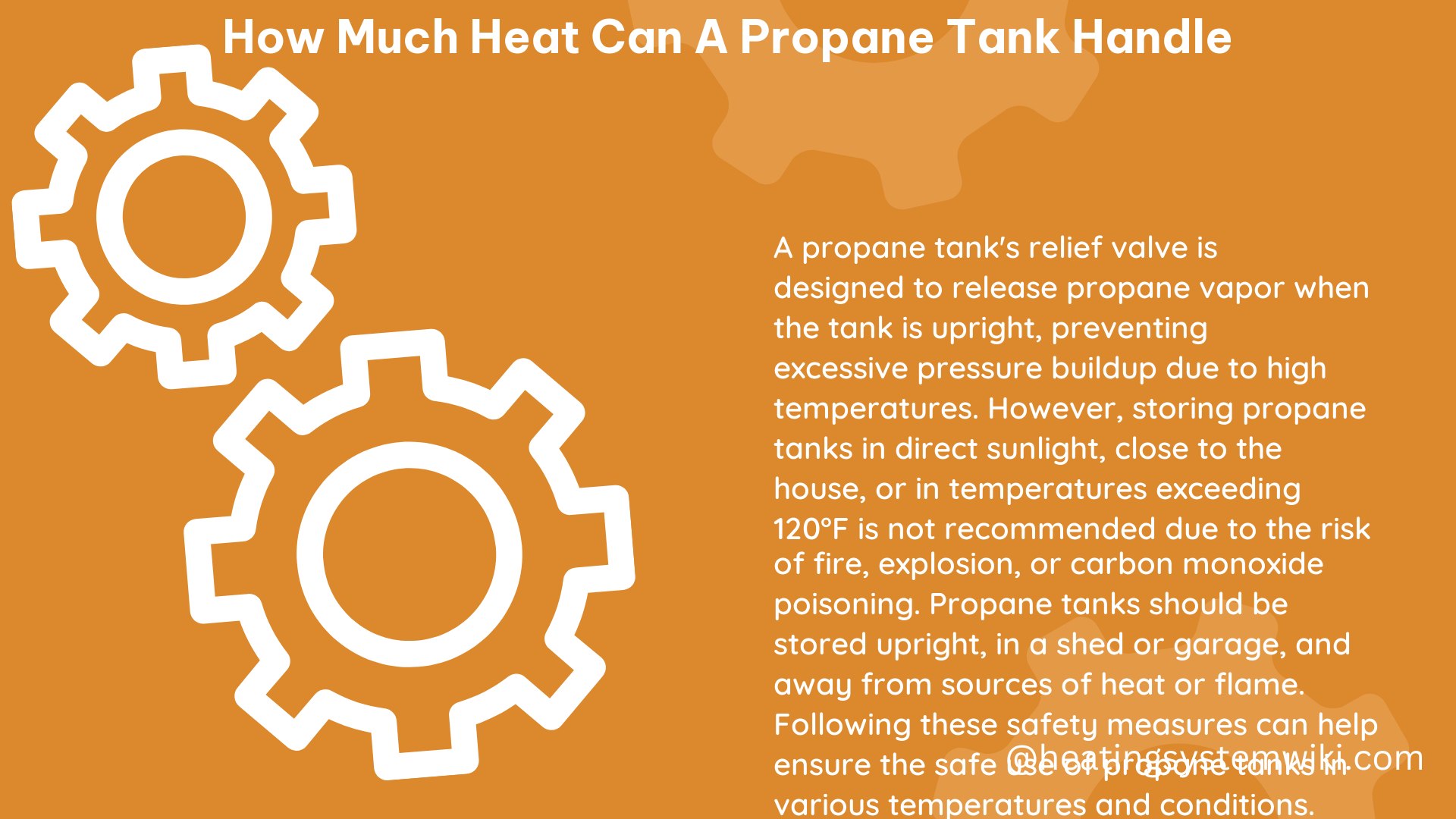Propane tanks are designed to withstand high temperatures, but there are limits to the amount of heat they can safely endure. Understanding these limits is crucial for ensuring the safe storage, handling, and transportation of propane tanks. In this comprehensive guide, we’ll explore the technical details and safety considerations surrounding the heat tolerance of propane tanks.
Understanding Propane Tank Temperature Limits
Propane tanks are typically designed to handle temperatures up to 120 degrees Fahrenheit (49 degrees Celsius). This is the maximum temperature that a propane tank can safely withstand without significantly increasing the risk of an explosion or other hazardous events.
To put this into perspective, a car parked in direct sunlight on a hot day can reach temperatures of up to 160 degrees Fahrenheit (71 degrees Celsius). This means that leaving a propane tank in a hot car can be extremely dangerous and could potentially lead to an explosion.
Propane Tank Safety Features

Propane tanks are designed with various safety features to prevent explosions and other hazardous incidents. One of the most important safety features is the pressure relief valve, which is designed to release excess pressure if the temperature inside the tank gets too high.
The pressure relief valve is a crucial component that helps to prevent the tank from rupturing or exploding. When the temperature inside the tank rises, the pressure also increases. If the pressure becomes too high, the relief valve will open, allowing the excess pressure to be released safely.
Factors Affecting Propane Tank Heat Tolerance
Several factors can influence the heat tolerance of a propane tank. These include:
-
Tank Material: Propane tanks are typically made of steel, which has a higher heat tolerance than other materials, such as aluminum.
-
Tank Size: Larger propane tanks generally have a higher heat tolerance than smaller tanks, as they have a greater volume-to-surface area ratio.
-
Tank Pressure: Propane tanks are designed to operate at specific pressure levels. Exceeding these pressure limits can increase the risk of an explosion or other hazardous events.
-
Tank Age and Condition: Over time, propane tanks can become worn or damaged, which can reduce their heat tolerance and overall safety.
Proper Propane Tank Storage and Handling
To ensure the safe storage and handling of propane tanks, it’s essential to follow these guidelines:
-
Keep Tanks Out of Direct Sunlight: Avoid storing propane tanks in direct sunlight or near other heat sources, such as grills, furnaces, or appliances.
-
Store Tanks Upright: Propane tanks should always be stored in an upright position to prevent the release of liquid propane, which can be extremely dangerous.
-
Avoid Transporting Tanks in Hot Vehicles: If you need to transport a propane tank, do so in a well-ventilated area and avoid leaving the tank in a hot vehicle for extended periods.
-
Use Stabilizers and Holders: When transporting propane tanks, use a stabilizer and holder to keep the tank in a vertical, upright position.
-
Follow Manufacturer Guidelines: Always refer to the manufacturer’s instructions and safety guidelines for the proper storage, handling, and transportation of propane tanks.
Propane Tank Inspection and Maintenance
Regular inspection and maintenance of propane tanks are essential for ensuring their safe operation and heat tolerance. This includes:
-
Visual Inspection: Regularly inspect the tank for any signs of damage, rust, or wear and tear.
-
Pressure Testing: Periodically have the tank’s pressure tested to ensure it is within the recommended range.
-
Valve and Regulator Inspection: Check the tank’s valve and regulator for proper functioning and any signs of wear or damage.
-
Replacement: Replace the tank if it shows signs of significant wear or damage, or if it has exceeded its recommended lifespan.
Conclusion
Propane tanks are designed to handle high temperatures, but there are limits to the amount of heat they can safely withstand. By understanding these limits and following proper storage, handling, and maintenance procedures, you can ensure the safe use of propane tanks and minimize the risk of hazardous incidents.
Remember, the maximum safe temperature for a propane tank is typically around 120 degrees Fahrenheit (49 degrees Celsius). Exceeding this limit can significantly increase the risk of an explosion or other dangerous events. Always prioritize safety when working with propane tanks, and consult the manufacturer’s guidelines for specific instructions and recommendations.
References:
- Can Propane Tanks Explode In a Hot Car? – Wheat Energy (https://wheatenergy.net/can-propane-tanks-explode-in-a-hot-car/)
- What I’ve Learned About Propane and Portable Cylinders (https://countryplans.com/smf/index.php?topic=10186.0)
- Propane Tank Safety in High Temperatures: What You Need to Know (https://www.kauffmangas.com/blog/propane-tank-safety-in-high-temperatures-what-you-need-to-know/)
- How are you supposed to store propane tanks safely? You’re supposed to: never keep indoors, dont store close to the house, keep out of direct sun light, keep out of 120 degrees+. Seem impossible to store in the summer time. (https://www.reddit.com/r/preppers/comments/jln18n/how_are_you_supposed_to_store_propane_tanks/)
- Propane Safety and Extreme Heat: 10 Tips to Keep Your Family Safe (https://www.crystalflash.com/support/propane-safety-extreme-heat/)
